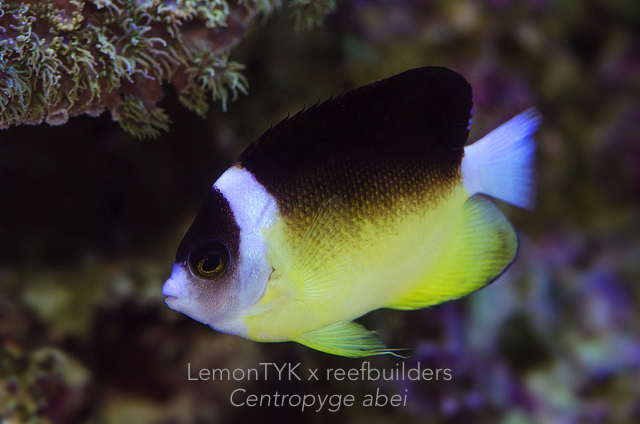If you ever visit Hawaii and don’t stop by the Waikiki aquarium, consider yourself a felon and a convicted criminal for breaking the fish geek code. In a small public aquarium within the Waikiki neighbourhood of Honolulu lives two mega superstars of the fish world. Well three if you count the peppermint angelfish.

Centropyge abei is a legendary semi-mythical angelfish best known from the almost viral deep dive video and photos that Brian Greene and Richard Pyle are notoriously known for. The species was first known in 2001 during a survey of Palau by a research submersible at a depth of 110-150m (360-490ft). It was only four years later in 2005, where another specimen was seen and obtained by Forrest Young from Sulawesi at 120m (393ft). The Indonesian specimen eventually served to become the holotype when it was officially described in 2006, with Manado-Tua, Sulawesi being its official type locality.
The habitat of C. abei in Manado was reported to consist of steep inclined boulders with water temperatures at 21-22 C (70F). On the other hand, temperatures were a few degrees cooler in Palau at 17-22 C (63-72F) where it was observed. In both localities, C. abei was never observed above 100m (330ft).

C. abei is however more often seen in Palau during deep dive expeditions, and the adult specimen in Waikiki was collected by Dr. Richard Pyle in 2007 and donated to the Waikiki Aquarium. It comes as a huge surprise then, just a year after its description in 2007, that a 3 cm long juvenile was documented at 5m (16ft) in Miyazaki, Japan. The specimen was thought to be a waif from deepwater Philippines nearby which drifted and eventually recruited in the shallow reefs of Miyazaki. The juvenile was observed for two months in 17C (33.8F) waters before eventually disappearing.
Genetically, C. abei is mysterious and taxonomically unclear in its generic placement. While showing signs of Centropyge, Apolemichthys and Chaetodontoplus, it was eventually provisionally placed as a “modified Centropyge” in the genus. Its deep dwelling nature and unique morphological features and coloration distinguishes it from all known angelfish species, and it could possibly belong near the base of the phylogenetic tree. A DNA study is definitely needed to see where it sits in the angelfish tree, and if a new genus should be erected for the species.

The other black and yellow beauty to share the same status as Centropyge abei at the Waikiki Aquarium is Chaetodon smithi. Unlike C. abei, C. smithi is at the total opposite end of the depth spectrum. We did a full article on this species here, when Ian Skipworth released stunning stunning HD photos of the species in the wild. We’ll keep it short on the C. smithi description, but for more information, click on the link above.
As we’ve mentioned, C. smithi is a species of fairly shallow waters found in the far flung isolated islands of Rapa Iti and the Pitcairn group. Despite being found only in 10-30m (30-100ft), the incredibly isolated range and logistical nightmare protects this fish from collection. Taxonomically, it appears to fit more appropriately in Hemitaurichthys, where it did for awhile, before it was moved to Chaetodon. It appears to be most closely related to the Eastern Island endemic Chaetodon litus.

This particular fish is the only individual on public display, and it has been 13 years since the day it was taken from the wild. Brian Greene first collected this individual at 2 inches back in 2002 from Rapa Iti, and since then the fish has grown to its maximum size and cruises the main display of the Waikiki Aquarium.
Chaetodon smithi is really a simplistic looking animal but it truly is one of my all time favourite fish, and seeing this along with C. abei in person really blew my mind. The Waikiki Aquarium is home to many other rare fish as well, such as Paracentropyge boylei, the peppermint angelfish which shares its tank with C. abei. The Striped Boarfish (Evistias acutirostris) also calls the Waikiki Aquarium its home, along with 8 Genicanthus personatus and various other endemics in a Hawaiian biotope display.
Rare as all these fish may be, they suddenly appear invisible next to these illustrious black and yellow beauties. If you do visit Hawaii, stop by the Waikiki Aquarium and pay these guys a visit while they’re still around. It is the only place in the world where you can.



